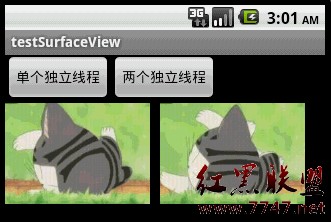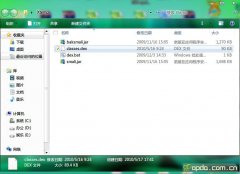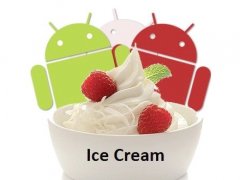Android提高第三篇之SurfaceView(下)
上一篇简单介绍了SurfaceView的使用,这次就介绍SurfaceView的双缓冲使用。双缓冲是为了防止动画闪烁而实现的一种多线程应用,基于SurfaceView的双缓冲实现很简单,开一条线程并在其中绘图即可。本文介绍基于SurfaceView的双缓冲实现,以及介绍类似的更高效的实现方法。
本文程序运行截图如下,左边是开单个线程读取并绘图,右边是开两个线程,一个专门读取图片,一个专门绘图:

对比一下,右边动画的帧速明显比左边的快,左右两者都没使用Thread.sleep()。为什么要开两个线程一个读一个画,而不去开两个线程像左边那样都“边读边画”呢?因为SurfaceView每次绘图都会锁定Canvas,也就是说同一片区域这次没画完下次就不能画,因此要提高双缓冲的效率,就得开一条线程专门画图,开另外一条线程做预处理的工作。
main.xml的源码:
view plaincopy to clipboardprint?
<?xml version="1.0" encoding="utf-8"?>
<LinearLayout xmlns:android="http://schemas.android.com/apk/res/android"
android:layout_width="fill_parent" android:layout_height="fill_parent"
android:orientation="vertical">
<LinearLayout android:id="@+id/LinearLayout01"
android:layout_width="wrap_content" android:layout_height="wrap_content">
<Button android:id="@+id/Button01" android:layout_width="wrap_content"
android:layout_height="wrap_content" android:text="单个独立线程"></Button>
<Button android:id="@+id/Button02" android:layout_width="wrap_content"
android:layout_height="wrap_content" android:text="两个独立线程"></Button>
</LinearLayout>
<SurfaceView android:id="@+id/SurfaceView01"
android:layout_width="fill_parent" android:layout_height="fill_parent"></SurfaceView>
</LinearLayout>
<?xml version="1.0" encoding="utf-8"?>
<LinearLayout xmlns:android="http://schemas.android.com/apk/res/android"
android:layout_width="fill_parent" android:layout_height="fill_parent"
android:orientation="vertical">
<LinearLayout android:id="@+id/LinearLayout01"
android:layout_width="wrap_content" android:layout_height="wrap_content">
<Button android:id="@+id/Button01" android:layout_width="wrap_content"
android:layout_height="wrap_content" android:text="单个独立线程"></Button>
<Button android:id="@+id/Button02" android:layout_width="wrap_content"
android:layout_height="wrap_content" android:text="两个独立线程"></Button>
</LinearLayout>
<SurfaceView android:id="@+id/SurfaceView01"
android:layout_width="fill_parent" android:layout_height="fill_parent"></SurfaceView>
</LinearLayout>
本文程序的源码:
view plaincopy to clipboardprint?
package com.testSurfaceView;
import java.lang.reflect.Field;
import java.util.ArrayList;
import android.app.Activity;
import android.graphics.Bitmap;
import android.graphics.BitmapFactory;
import android.graphics.Canvas;
import android.graphics.Paint;
import android.graphics.Rect;
import android.os.Bundle;
import android.util.Log;
import android.view.SurfaceHolder;
import android.view.SurfaceView;&n
相关新闻>>
- 发表评论
-
- 最新评论 进入详细评论页>>





